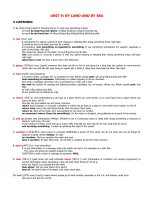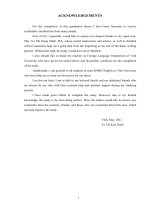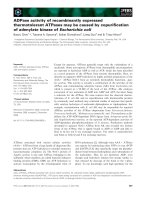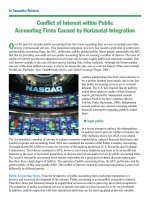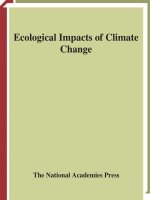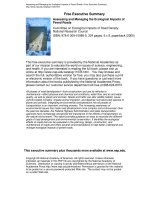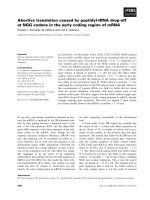Possible ecological impacts caused by sea cage farm activities on surrounding coral reef ecosystem in nha trang bay, vietnam
Bạn đang xem bản rút gọn của tài liệu. Xem và tải ngay bản đầy đủ của tài liệu tại đây (2.33 MB, 68 trang )
MINISTRY OF EDUCATION AND TRAINING
NHA TRANG UNIVERSITY
___________________________
NGUYEN THU HIEN
POSSIBLE ECOLOGICAL IMPACTS CAUSED BY SEA-CAGE
FARM ACTIVITIES ON SURROUNDING CORAL REEF
ECOSYSTEM IN NHA TRANG BAY, VIETNAM
MASTER THESIS
KHANH HOA – 2017
MINISTRY OF EDUCATION AND TRAINING
NHA TRANG UNIVERSITY
___________________________
NGUYEN THU HIEN
POSSIBLE ECOLOGICAL IMPACTS CAUSED BY SEA-CAGE
FARM ACTIVITIES ON SURROUNDING CORAL REEF
ECOSYSTEM IN NHA TRANG BAY, VIETNAM
MASTER THESIS
Marine Ecosystem Management and
Major:
Climate Change
772/QD-DHNT, dated 20/9/2016
Topic allocation Decision:
Decision on establishing the Committee:
01/06/2017 – 05/06/2017
Defense date:
Suppervisors:
Dr. Nguyen Lam Anh
Chairman:
Associate Prof. Ngo Dang Nghia
Faculty of Gradute Studies:
Faculty of Economics
KHANH HOA – 2017
UNDERTAKING
I undertake that the thesis entitled: “Possible ecological impacts caused by seacage farm activities on surrounding coral reef ecosystem in Nha Trang Bay, Vietnam”
is my own work. The work has not been presented elsewhere for assessment until the time
this thesis is submitted.
Nha Trang, 03, May, 2017
(Signature and full name)
Nguyen Thu Hien
i
ACKNOWLEDGMENT
I wish to express my sincere appreciation to the following organizations and
persons for their invaluable support, help and encouragement to me in conducting this
study:
The Norwegian Programme for Capacity Development in Higher Education and
Research for Development (Noherd) for giving me the opportunity to study and conduct
this master thesis on Marine Ecosystem based Management and Climate Change.
The Faculty of Economics and Institute of Marine science and Fishing
Technonogy in Nha Trang University; Section of Marine Ecology, Institute of
Oceanography of Nha Trang; Nha Trang Institute of Technology Research and
Application for supporting facilities, materials, apparatuses, equipment for helping and
giving best conditions for me to finish my thesis.
My special thanks go to Prof. Sigurd Stefansson, Prof. Henrik Glenner and Dr.
Lam Anh for the continuous support of my Master study and research, for their patience,
motivation, enthusiasm, and immense knowledge. Their guidance helped me in all the
time of research and writing of this thesis.
To Dr. Hoang Trung Du and Dr. Pham Trung San for their guidance and
invaluable suggestions, their support, encouragement and flexibility, often beyond his call
of responsibility. Furthermore, I wish to express my profound gratitude for their
stimulating comments and discussions, their ability to positively give and receive
information, their openness towards freedom of expression, choices and their monumental
patience shown during the research program. Actually, their enthusiasm and integral view
on research has made such a deep impression on me.
To all members of Section of Marine Ecology, Institute of Oceanography of Nha
Trang and my colleagues in Corrosion Research Department, Nha Trang Institute of
Technology Research and Application for their cooperation, for all the kindness and
friendship.
ii
Last but not the least, I would like to thank my family: my parents, my husband
and to my brothers and sisters for supporting me spiritually throughout writing this thesis.
Thank you!
Nha Trang, 03, May, 2017
(Signature and full name)
Nguyen Thu Hien
iii
TABLE OF CONTENTS
UNDERTAKING .................................................................................................................. i
ACKNOWLEDGMENT ......................................................................................................ii
TABLE OF CONTENTS .................................................................................................... iv
LIST OF SYMBOLS ........................................................................................................... vi
LIST OF ABBREVIATION .............................................................................................. vii
LIST OF TABLES ............................................................................................................viii
LIST OF FIGURES ............................................................................................................. ix
ABSTRACT ......................................................................................................................... x
INTRODUCTION .............................................................................................................. 1
Research objectives .............................................................................................................. 3
Research contents ................................................................................................................. 3
Hypotheses ........................................................................................................................... 3
Research questions ............................................................................................................... 4
CHAPTER 1: LITERATURE REVIEW ......................................................................... 5
1.1. OVERVIEW OF RESEARCH SITUATION ABROAD ............................................. 5
1.1.1. Aquaculture activities ................................................................................................. 5
1.1.2. The impacts of aquaculture activities to environment and ecosystems ..................... 6
1.2. OVERVIEW OF DOMESTIC RESEARCH SITUATION .......................................... 9
1.2.1. Aquaculture activities ................................................................................................. 9
1.2.1.1. Aquaculture operations in South Central coastal provinces.................................... 9
1.2.1.2. Aquaculture activities in Khanh Hoa province ..................................................... 10
1.2.2. The impacts of aquaculture activities to environment and ecosystems ................... 16
1.3. THE IMPACTS OF EUTROPHICATION AND SEDIMENTATION ON CORAL
REEF .................................................................................................................................. 18
1.4. CLIMATE CHANGE FROM THE PERSPECTIVE OF STUDYING THE
ANTHROPOGENIC IMPACTS BY AQUACULTURE .................................................. 20
CHAPTER 2. MATERIALS AND METHODOLOGY ............................................... 22
2.1. DATA SOURCE USED .............................................................................................. 22
2.2. SAMPLING STRATEGIES........................................................................................ 22
iv
2.2.1. Study sites and sampling design ............................................................................... 22
2.2.2. Sediment sampling ................................................................................................... 23
2.2.3. Conducting field experiments (coral cross-transplanted)......................................... 24
2.3. THE METHOD OF SAMPLES ANALYZED ........................................................... 25
2.3.1. Sediment samples ..................................................................................................... 25
2.3.2. Coral samples analysis: ............................................................................................ 27
2.4. DATA PROCESSING METHODS ............................................................................ 28
CHAPTER 3. RESULTS AND DISCUSSION .............................................................. 29
3.1. THE ASSESSMENT OF EUTROPHICATION IN DIFFERENT SITES ................. 29
3.2. SEDIMENT CHARACTERISTIC AND SEDIMENT QUALITY ............................ 32
3.4. FFIELD EXPERIMENT – CORAL TRANSPLANTATION .................................... 38
CHAPTER 4: CONCLUSION AND RECOMMENDATION..................................... 41
REFERENCES ................................................................................................................. 43
APPENDICES
v
LIST OF SYMBOLS
NT1, NT2, NT3:
Near-field farming sites
NT4, NT6:
Mid-filed farming sites (1.2km from the breeding areas)
NT5, NT7:
Far-field farming sites
M0:
Weight of aluminum cup
M1:
Weight of sample and aluminum cup
M2:
Weight of samples and aluminum cup dried in an oven for 48 hours
at 80oC
M3:
Weight of samples after mashed, restored in other aluminum cup
M4:
Weight of samples after burned at 550oC in 4 hours
ChA:
Chlorophyll-a concentration, as µg/l
aD%O:
Oxygen as absolute % deviation from saturation
L:
The amount of Nitrogen or Phosporous discharged into the
environment (kg/m2)
P:
Total production (kg/m2)
Fc /FCR:
Feed conversion ratio
Cfeed:
The content of N/P in feed (%)
Cfish:
The content of N/P in feed inside the lobster, fish meat (%)
vi
LIST OF ABBREVIATION
IPCC:
LC50:
Intergovernmental Panel on Climate Change
The lethal concentration required to kill 50% of the population
NCAR:
Anthropologists at National Center for Atmospheric Research
AAA:
American Anthropological Association
DIN:
Dissolved inorganic nitrogen
DIP:
Dissolved inorganic phosphorus
VAST:
VietNam Academy Of Science And Technology
TOM:
Total Organic Matter
TOC:
Total Organic Carbon
GF/F:
The grade of Whatman paper used for filting extremely fine precipitates
such as protein, nucleic acids, or serum precipitates
HOBO:
The device used for measuring air temperature, relative humidity, dew
point, rainfall, soil moisture, solar radiation, wind speed and direction,
barometric pressure, and more.
TN:
Total Nitrogen
TP:
Total Phosphorus
CHNO-S:
Elemental analyser for analyzing Carbon, Hydrogen, Nitrogen, Sulfur and
Oxygen content
TSM:
TRIX:
FCR:
Total suspended matter
Trophic Index
Feed conversion ratio
vii
LIST OF TABLES
Table 1.1: Production of main species groups of fish from marine and coastal aquaculture
in 2014 .................................................................................................................................. 5
Table 1.2: Current status of fisheries and aquaculture in the South Central Province from
2009 to 2013 ......................................................................................................................... 9
Table 1.3: Current status of fisheries and aquaculture in Khanh Hoa Province from 2009
to 2014 ................................................................................................................................ 10
Table 1.4. Summary of the commonly cultured species in Khanh Hoa Province ............. 13
Table 1.5: The development of lobster farming in Nha Trang bay from 2005 to 2011 ..... 15
Table 3.1: The nutrient concentration in Nha Trang Bay in two sampling periods. .......... 29
Table 3.2: The Estimation of waste output from lobster cage farm activities in 2015 ...... 37
viii
LIST OF FIGURES
Figure 1.1: Distribution of five cultured areas in Nha Trang bay ...................................... 15
Figure 2.1: Map of sampling sites in the cage farming areas of Nha Trang Bay............... 23
Figure 2.2: Sediment Grab for sampling sediment samples ............................................... 24
Figure 2.3: Diagram of sediment traps deployed in the transects ...................................... 24
Figure 2.4: Coral transplantation sites. Red circle: near-field of cage farming area (major
affected by cage farming). Green circle: far-field of cage farming area (less
affected area). ..................................................................................................................... 25
Fig 3.1: The nutrient concentration in Nha Trang Bay in two sampling periods ............... 30
Fig 3.2: TRIX Index in May 2015 ...................................................................................... 31
Fig 3.3: TRIX Index in April 2016..................................................................................... 31
Fig 3.4: TOM (%) in surface layer sediment at different sites in 2015 and 2016 .............. 33
Fig 3.5: TOC (mg/kg) in surface layer sediment at different sites in 2015 and 2016 ........ 33
Fig 3.6: The distribution of TN and TP in surface-layered sediment at different sites in
two sampling times 2015 and 2016 .................................................................................... 35
Fiure 3.7: Sedimentation rates in the study sites of Nha Trang Bay in 2015 and 2016 ..... 36
Figure 3.8: The distribution of TOM in sediment traps at the study sites of Nha Trang Bay
in May, 2015 and 2016 ....................................................................................................... 36
Figure 3.9: the different experiment of coral transplantation in clearly site (2) and near-by
the fish farm (1) are in Hon Mot Island. Nha Trang bay during 31days ............................ 39
Fig 3.10a: The results after one month of experiment at far-field site: (A): At the
beginning of experiment (first day); (B) after 31 days ....................................................... 39
Fig 3.10b: The results after one month of experiment at near-field site: (A): At the
beginning of experiment (first day); (B) after 31 days ....................................................... 40
Figure 3.11: The results of zooxanthella densities at the staring experimental time and
after a month in Hon Mot Island ........................................................................................ 40
ix
ABSTRACT
Nha Trang Bay is located in the area of Nha Trang City, Khanh Hoa Province, the
area of south-central coast, Vietnam. It is suitable for the travelling and anchoring of
vessels together with surface aquaculture (cages). However, the environment in Nha
Trang Bay is suffering serious degradation due to overloading of farming density.
Based on the survey and analyzing data of VAST05.03/15-16 project and the
results of experiments on sediment samples in Nha Trang Bay. We have assessed the
impact of sea-cage culture activities on the degradation of coastal waters. The results
showed that the nitrogen content in the high nutrient (N) in the study area: the average
content of dissolved inorganic nitrogen (DIN) was 177.4 μg/l in 2015 and 141.7 μg/l in
2016. At most survey sites The N:P ratios were larger than 16, it has been shown that
phosphorus salts may be the limited nutritional factor in these coastal waters. TRIX
indexs were recorded for both the surface and bottom water bodies in the range of 5-6,
which indicated that the level of eutrophication was high and water quality is not good.
Especially in cage culture areas and surroundings.
The TOC levels in the analyzed sediments were in the range of sediments with low
organic carbon level. Research also suggests that sediment rates ranged from 1.24 to 3.03
mg cm-2d-1 may not affect the development and recruitment of coral reefs surrounded. The
estimation of nitrogen and phosphorus concentrations discharged into the environment,
with a yield of 0.389 kg/m2 in 2015, were 58.48 tonnes and 29.79 tonnes, respectively for
1 ton of commercial lobster.
The coral transplantation experiments indicated that the amounts of mucus
produced per algae was lower but the total amount of algal blooms is higher. This study
confirms the negative effects that nutrient levels have on corals themselves. The
increasingly development of human activities that are threatened by anthropogenic
pollutants. Sea cage farming is one of the stressors negatively impacting coral reefs by
being point sources of nutrients and other effluents.
Key word: Eutrophication, TRIX index, nutrients, coral reef, and sea-cage farm
x
INTRODUCTION
Nha Trang Bay is located in the area of Nha Trang City, Khanh Hoa Province, the
area of south-central coast, Vietnam. It is listed as one of 29 most beautiful bays in the
world, with its islands and white sand beaches. This place has diverse resources and
landscapes with specific ecological characteristics of the tropics, including many marshes,
bays, estuaries etc. It is suitable for the travelling and anchoring of vessels together with
surface aquaculture (cages). Its marine surface area is about 40,000 hectares, adjacent to
offshore waters, where has the combination of ocean currents, upwelling zones.
Therefore, Nha Trang Bay often receives multiple streams of floating and migratory fish.
In addition, it has internationally important coral reefs with the highest coral
biodiversity recorded in Vietnam. Despite the pressure from economic development, Nha
Trang Bay retains some of the very few intact coral reefs in Vietnam. Coral reef
ecosystems have more than 222 species of reef fish, 350 species of coral (40% of the
coral reef in the world), 120 species of mollusks, 70 crustaceans, 30 species of
echinoderms, 70 species of seaweed and 7 species sea grass etc. The environment in Nha
Trang Bay is suffering serious degradation due to overloading of farming density. From
2009 to present Nha Trang Bay experienced strong growth in the aquaculture industry.
Water surface area of aquaculture in 2015 was 5.8 thousand ha, has increase of 0.9
thousand ha compared to 2009. Aquaculture output increased 5 times from 2825 tones
(2009) to 14 270 tones (2015). (The General Statistics Office, 2015). Moreover, the
aquaculture was spontaneous, fragmented and not planned; the disputes of farming
grounds always caused chaos which made the environmental situation worsening (Trang,
et al., 2009). Organic wastes from aquaculture including leftover feed, settling, wastes
from living activities, chemicals… have caused numerous environmental problems (Du,
et al., 2006). The amount of nutrients as well as organic matter from uneaten feed (only
17% by weight of feed supply is converted to biomass) was directly discharged into the
environment (Hoang Trung Du, 2006). It leads to heavily contaminated water bodies,
eutrophication and increasing aquatic diseases to livestock, coral reefs and benthic fauna.
The coral communities in the bay have significantly deteriorated compared to the results
1
of the first hydro-biological surveys in the early 1980s. By the beginning of the 21st
century, the average coral cover in the bay was less than 30% (Tkachenko, 2015).
Climate change is intensifying the symptoms of eutrophication and sediment on
coral reefs. However, eutrophication can also conversely promote climate change (Moss
et al., 2011). Eutrophication may lead to lower proportionate dependence on imported
organic matter and greater autotrophic fixation of carbon dioxide; nonetheless, it also
leads to increased absolute production and respiration, greater release of methane from
deoxygenated waters and sediments, (Bastviken et al. 2008, 2011), and more nitrous
oxide from denitrification (Huttunen et al. 2003). Both the latter gases are more effective
greenhouse gases than carbon dioxide (Moss et al., 2011).
Different global climate change scenarios can manifest themselves by varying
effects on different components of the ecosystem. These results may be difficult to detect
because of the effects of human-induced changes but are now covered by the inherent
"background" of natural systems (Sanderson et al. Halpern et al., 2008). As in the sense of
human-induced tensions, we can not completely differentiate between the global climate
change aspect and the anthropological aspect of global change for eutrophication Because
of the overlap in pressures and consequences (Rabalais, NN, et al.).
One of the biggest threats to coral reef health is the direct human impacts of
eutrophication and sedimentation from concentrated aquaculture. Because in coastal
areas, the effects of climate change on corals are unclear, mainly related to abnormal
rainfall causing floods and high suspended solids into the coastal zone. While human
impacts on the climate of this period are more prevalent due to changes in the natural
processes (IPCC, 2007). Nowadays, the problem is much larger in scale (Wilkinson
1999). 50-70% of coral reefs are directly affected by anthropogenic global climate change
(Hoegh-Guldberg 1999).
Recent studies on the impacts of eutrophication and sediment from cage
aquaculture on coral reefs have remained modest and have only focused on the effects of
sediment pollution in the mangroves as well as tidal flats (Quy, et al., 2011; Tue, 2011).
The lack of research data about the impacts of cage aquaculture on coral reef makes
decision makers suffer troubles in marine spatial planning for aquaculture, tourism and
2
conservation (Yee, et al., 2015). Therefore, the study of sediment impacts caused by seacage farm activities on coral reef in Nha Trang Bay is a pressing need. Recognize the
essential of the problems I carry out the study about “Possible ecological impacts caused
by sea-cage farm activities on surrounding coral reef ecosystem in Nha Trang Bay,
Vietnam”.
Research objectives
-
This study aim to estimate the impact of sea-cage farming on marine
ecosystem and coral reef ecosystem in Nha Trang Bay.
Research contents
-
Assessment of water quality of the water through the TRIX Index in Nha
Trang Bay.
-
Determine sediment characteristic and sediment quality at 7 different sites
in Nha Trang Bay, thereby assessing sediment quality and sediment
contamination level.
-
Estimation of Nitrogen/Phosphorous contents from the the cages discharged
into the environment.
-
Carry out field experiment - coral transplantation to determine the effects of
sedimentation and eutrophication on coral reefs in the bay.
Hypotheses
-
Impacts of from sea cage activities on sediment bottom, especially from
uneaten feed and faeces causes severe pollution in water and sediment
quality in cage farming area and vicinity.
-
Exposure to elevated sedimentation for repeated or prolonged periods of
time has lead to reduced coral recovered and recruitment, or declining
biodiversity due to the loss of sensitive taxa.
3
Research questions
-
How to test the potential impacts from sea cage farming to the coastal
waters of Nha Trang Bay?
-
How these effects from sea-cage activities influence on the coral reef
surrounded (especially on the coral species Acropora sp.)?
4
CHAPTER 1: LITERATURE REVIEW
1.1. OVERVIEW OF RESEARCH SITUATION ABROAD
1.1.1. Aquaculture activities
Fish is farmed for many thousands of years. However, the farming of marine
species is more demanding than freshwater fish. Aquaculture in the past and the present
periods these kinds of omnivores or shellfish have provided a source of easy and reliable
harvesting of food (Kaiser, et al., 2011). Cage aquaculture is increasing worldwide, with
the cage aquaculture of high value finfish the fastest growing sector. (Delgado, et al.,
2003) predicted that fish consumption in developing countries will rise by 57%, from 62.7
million metric tons in 1997 to 98.6 million in 2020, and cage culture is expected to play a
important role in meeting the demand (Tacon, et al., 2007).
In Asia, more than 95% of marine finfish aquaculture is in cages, (De Silva, et al.,
2007). The production of the Pacific region and Asia in 2010 reached 53.1 million tonnes,
accounting for 89% global production (59.9 million tonnes) (Funge-Smith, et al., 2012).
The top three marine and coastal aquaculture regions in 2014 were Asia, Europe and
Americas and their production were accounting for 81.2%, 9.2% and 8.3% of world
production, respectively (FAO, 2016).
Table 1.1: Production of main species groups of fish from marine and coastal aquaculture
in 2014
Region
Groups of fish
Production Tonnes)
Finfish
12818
Molluscs
3708
Crustaceans
5108
Africa
Other animals
1
Total Africa
21631
Finfish
1018460
Molluscs
539989
Crustaceans
652610
Americas
Other animals
Total Americas
2211059
Finfish
3388124
Molluscs
14545398
Asia
Crustaceans
3507019
Other animals
370538
5
Europe
Oceania
World
Total Asia
Finfish
Molluscs
Crustaceans
Other animals
Total Europe
Finfish
Molluscs
Crustaceans
Other animals
Total Oceania
Finfish
Molluscs
Crustaceans
Other animals
TOTAL WORLD
21811079
1820109
631789
241
824
2452963
63124
114566
5558
1354
184602
6302631
15835450
4170536
372718
26681334
Source: (FAO, 2016)
1.1.2. The impacts of aquaculture activities to environment and ecosystems
- Redundant feed direct discharged into the environment
The small-scale aquaculture in Asia is currently constrained by a number of factors
including inadequate access to finance, a lack of technical innovations, an absence of feed
formulation and processing knowledge, and training. Therefore, it often encounters with
redundant feed and which led to decrease productivity and increase cost (Shipton, et al.,
2013). Wastes arised from feeds includes a solid particulate fraction comprising uneaten
and undigested feed and faeces, and a dissolved fraction comprising metabolic byproducts, urea, phosphate and principally ammonia (Bergheim, et al., 2003). The quality
and quantity of the effluent will vary depending on culture species, the production system,
and the physical and nutritional characteristics of the feed (Shipton, et al., 2013). For
industrial culture ponds, wastes in the pond can hold up to 45% nitrogen and 22% of other
organic substances. (Pearson, et al., 1978).
-
Organic wastes deposited in sediment
Organic wates generated in aquaculture operation comprise formulated feed and
faeces (including urine) and waste (unconsumed) feed (Cho, et al., 1998). Wastes and
faeces can be a significant contributor of organic carbon to sediments, approximately 20%
6
carbon in feed is transformed into faece (Silvert, 1994). Organic pollutants deposited in
the sediment will initially provide food to the bottom ecosystem and stimulate the
production of macro-fauna and aerobic bacteria. When oxygen demand for bottoms
exceeds the available amount, aerobic processes are converted to anaerobic processes,
reducing and/or altering macro-fauna. The bottom becomes oxygen-deficient and can be
sterile by gases such as methane and hydrogen sulphide. Sedimention rates from 0.1 to
1.0 gC/m2/d (Hargrave, 1985) and those figures for fish faeces and waste feed are lager
than 1.0 gC/m2/d cam caused significant organic contamination (Wildish, et al., 2004). It
will reduce the flow underneath the fish cages and increases the amount of organic waste
to the seabed; increases physiological stress on the aquatic community under the cages
and led to a decrease in biodiversity or, in extreme cases completely remove large
organisms living on the bottom, which is then replaced by bacteria (Pearson, et al., 1978).
A portion of solid particles will be brought to downstream due to the tide,
gradually reduce organic pollution around the cage. Farmers also try to reduce the amount
of leftover feed and move the cages regularly in order to ecosystems undergo restoration.
However, a few closed waters are overloaded with farms, because it is the place where
concentrate adverse impacts of cage culture, eliminating the possibility of solving the
problem by moving the cages. These systems are reducing dissolved oxygen levels in the
water column, increasing the stress levels for fish, susceptible to outbreaks. The
connection of cages and ropes to the seabed will increase the friction and thus it causes
flow turbulence of water bodies around the cages. (Hartstein, et al., 2004) found that
points which have highest average flow regime, got the lowest organic content percentage
and organic matter content at farming area was always higher than the surrounding areas.
Severely reduced the flow in the central area of ropes increased deposition speed.
-
Eutrophication caused by redundant feed and feaces
Aquaculture caused eutrophication due to receiving waters is similar to that
derivied from other points of polluted sources (Persson, 1991). However, most cultured
areas are limited dilution, then, nutrients are generally dissolved in the water and/or built
up in sediment where organic matter accumualted under the cages (Kaiser, et al., 2011).
7
In common feed regime, nutrients comprises 1.4 – 13.6% N and 0.3 – 5.9% P (Cho, et al.,
1998). Organic enrichment may lead to release of nutrients (N, P) from settled organic
wastes in sediment and therefore contributing eutrophication by shifting oligotrophic or
mesotrophic water bodies to eutrophic state (Environment-Canada, 2009). These
environmental changes in water column related to outbreaks of toxic algae and aquatic
mass mortality (Smayda, 1990).
-
Destruction of the natural ecological environment
In the early years of the shrimp industry, the areas occupied by mangrove forests
(mangroves) which are considered less economic value, are ideal for the development of
shrimp farms. They are natural habitats for many shrimp species and the best location for
shrimp farms (Fegan, 1996). The digging – pond preparation for breeding purposes has
destroyed 20% of the mangrove forests in Ecuador (Phillips, et al., 2003).
Today most countries culturing shrimp have recognized the importance of
mangroves. They are natural habitats and nurturing, foraging ecology of birds and
animals. They also prevent coastal erosion under the impact of storms and waves. The
balance between the profitability of shrimp farming and ecological benefits while
protecting mangroves in some countries have taken place to protect. In Thailand, only
12% of mangrove forests is outside protected areas are allowed shrimp farming and 61%
of the areas are maintained its natural state (Pongthanapanich, 1996).
Seed collection process also affect the ecological environment by capturing the
natural seed from the wild. These actions reduce feed intake of birds and increase the
physical impact on the seabed by fishing gear, trampling all over the beach. In addition,
the introduction of alien species when selecting brood stock can lead to habitat
disturbance when adding gravel, stone and other materials to create a solid foundation for
the bivalve development. Remove birds, fish, crabs from feeding grounds by using
protective nets. In harvest process can cause bottom disturbance by using mechanical
harvesting equipment and mass mortality of by-catch creatures in the culture areas.
8
1.2. OVERVIEW OF DOMESTIC RESEARCH SITUATION
1.2.1. Aquaculture activities
1.2.1.1. Aquaculture operations in South Central coastal provinces
The South Central coastal provinces including: Da Nang, Quang Nam, Quang
Ngai, Binh Dinh, Phu Yen, Khanh Hoa, Ninh Thuan and Binh Thuan.
The largest resource of these regions is marine economy in which fishery resources
(accounting for nearly 20% of the Vietnam’s catches) and aquaculture such as shrimp,
lobster, grouper, pearl etc. It is advantageous because of the appearance of many shrimp
and fishing grounds. In recent years, marine fish yield in the South Central coastal regions
accounted for more than 29% of the Vietnam’s catches. Particularly at the poles of South
Central, there are huge fishing grounds, many bays, lagoons etc. which are favorable for
aquaculture in Hoang Sa (Danang) and Truong Sa (Khanh Hoa). In Phu Yen and Khanh
Hoa, farming of lobster, black tiger shrimp are thriving.
According to the Department of Aquaculture (2012), lobster in Vietnam distributed from
Quang Binh to Binh Thuan, but is most concentrated in Phu Yen and Khanh Hoa
province. Lobster cage farming has really developed since 2000. Until now, the number
of estimated cages are more than 53,000 cages, over 23,627 cages in Phu Yen, Khanh
Hoa Province: 28 455 cages with approximately 8,000 - 10,000 households, production
reached 1,600 tons / year, bringing the turnover nearly 4,000 billion/year.
Table 1.2: Current status of fisheries and aquaculture in the South Central Province from
2009 to 2013
Year
2009
2010
2011
2012
2013
Water surface area of aquaculture
24.7
(thousand ha)
25.8
26.3
29.4
26.4
12027
11617
12209
12586
Offshore fishing vessels (unit)
11838
Fishery production (ton)
720303 748123 795201 846776 884352
Exploitation of fishery production
644709 684974 713945 764139 801084
(ton)
Exploitation
of
production (ton)
marine
fish
485.7
9
516.9
539.6
578.8
600.3
Aquaculture production (ton)
75594
77850
81254
82638
83261
Cultured fish production (ton)
16215
18104
19772
20194
21099
Farmed shrimp production (ton)
52095
51964
54985
53954
52967
Source: the General Statistics Office 2014
As seen from Table 1.2, in 2013, the water surface area of aquaculture of this area is 26.4
thousand hectares, increased of 2.27% compared to 2010, but decreased 10.2% compared
to 2012 because government launched a policy to protect the ocean and tourism (Decision
No. 2293 / QD-UBND). However the total aquaculture production of the whole region
still reached 83 261 tones, slightly decreased compared to 2012. Among them, farmed
shrimp production accounted for 63.6%, cultured fish production accounted for 25.3% of
total production.
1.2.1.2. Aquaculture activities in Khanh Hoa province
Aquaculture and fishing are mainly taken place in Nha Trang Bay, Khanh Hoa
Province. Nha Trang Bay focused on exploiting two main resources are fishing,
aquaculture and tourism. Fishing operations tend to develop in order to cater for the
processing industry and tourism. Presently, the aquaculture areas include: Tri Nguyen,
Hon Mot, Bich Dam and Dam Bay, Hon Mieu with a total area of about 263 ha. Fish
stock in the Bay accounts for approximately 30% of the total reserves of the province,
including pelagic fish stock about 70% (The General Statistics Office 2014).
Table 1.3: Current status of fisheries and aquaculture in Khanh Hoa Province from 2009
to 2014
Year
2009
2010
2011
2012
2013
2014
Water surface area of
aquaculture
(thousand ha)
4.9
5.6
6
8.8
5.7
5.8
Offshore fishing
vessels (units)
554
504
727
767
783
-
86568
88928
89088
93943
96051
-
Seafood production
(tons)
10
Preliminary
2015
Fisheries production
(tons)
74356
75242
75178
80160
82300
85000
Captured marine fish
production
(Thousand tons)
Aquaculture
production (ton)
66.3
68.7
68.7
71.9
73.3
76
2825
12212
13686
13910
13784
14000
Cultured fish
production (ton)
1535
2787
3501
3468
3527
-
Farmed shrimp
production (ton)
6949
7188
7857
7620
7047
6530
88000
14270
Source: the General Statistics Office 2014
* Captured fisheries: fishing yield in 2014 reached 85 thousand tons, equal to 95.18% of
the plan, an increase of 3.16% in comparison with 2013, of which more than 76 thousand
tons of fish, increased of 3.86%, more than 1.3 thousand tons of shrimp, increased
13.17% and other seafood.
* Aquaculture activities: Aquaculture in Nha Trang Bay is mainly semi-intensive
(intensive form of farming accounts for 20%, 80% semi-intensive). Aquaculture
production in 2014 reached 14 thousand tons, an increase of 1.81% compared to 2013, of
which over 6.1 thousand tons of whiteleg shrimp, an increase of 6.57%; 0.43 thousand
tons of shrimp, an decrease of 25.42% compared to 2013, due to many black tiger shrimp
farming households have switched to culture white shrimp (because of their short culture
period, high yield, less disease, high efficient economy). The shrimp and fish production
reached their peak in 2011. From 2012 to 2015, the production was lower due to in some
aquaculture areas were in cleared areas, must be relocated and some areas turn to other
aquatic species such as snail, sea bass, grouper ... aquaculture area in 2014 reached 5829.4
hectares, an increase of 1.5% in comparison with 2013 due to favorable weather for
farming all kinds of seafood, including black tiger shrimp farming area was 330 ha
decreased 36.3%, an area of white shrimp culture 2992.7 hectares, up 8.9%.
* The number of vessels in province around 3140, of which 2000 vessels operates in Nha
Trang Bay area. However, the vessels whose capacity of under 20 CV account for about
40% (1.246 vessels), about 780 vessels of high capacity (> 90 CV). Therefore, the
11
overexploitation of coastal resources is inevitable. Besides, destructive fishing and
collective methods such as bottom trawling, dynamiting, electrical impulses etc. make the
resources in the Bay are seriously threatened.
* The main cage culture types: are “lobster (Panulirus ornatus, P. hormarus, P. timpsoni,
and P. longipes). Groupers (Epinephelus bleekeri, E. akaara, sexfasciatus, E.
malabaricus, E. coioides, E. merra and Cephalopholis miniata), Seabass Lates calcarifer,
Yellowtail Seriola dumerilli, Sea bream Parargyrops edita, Snapper Lutjanus spp., Seahorse Hippocampus, Pearl oyster (Pinctada maxima, and P. martensii), and ornamental
fishes were also cultured in cages” (Tuan, 2003).
.
12
Table 1.4. Summary of the commonly cultured species in Khanh Hoa Province
Scientific name
& synonyms
Common
names
Distribution
Habitat
Seed supply
Culture form
E. malabaricus
Malabar
grouper,
Estuarine
grouper
Ton Kin gulf,
Southern Central Sea
Marine and brackishwater.
Coral, rocky reefs, sandy and
muddy bottoms, tidepools,
estuaries, mangrove; juveniles
occur in shallow coastal waters
and estuaries
wild
Cage, pond
Epinephelus
akaara
Hong Kong
grouper, Red
spotted grouper,
Red grouper
Ton Kin gulf,
Southern Central Sea
Marine, demersal; common in
rocky areas
wild
Cage, pond
E. merra
Honeycomb
grouper
Ton Kin gulf,
Southern Central Sea
Shallow-water coral reefs in
lagoons and bays
wild
Cage, pond
E. coioides
Orange-spotted
grouper
Ton Kin gulf,
Southern Central Sea
Marine and brackishwater
wild
Cage, pond
E. sexfasciatus
Sixbar grouper
Ton Kin gulf,
Southern Central Sea
Silty sand or muddy bottoms
wild
Cage, pond
E.bleekeri
Duskytail
grouper, Yellow
spotted grouper
Ton Kin gulf,
Southern Central Sea
Shallow rocky banks.
wild
Cage, pond
Cephalopholis
miniata
Coral hind
Southern Central Sea
Well-developed exposed coral
reefs, clear water
wild
Cage
13
